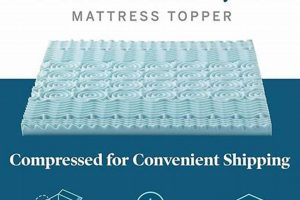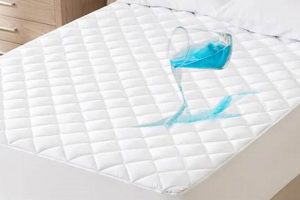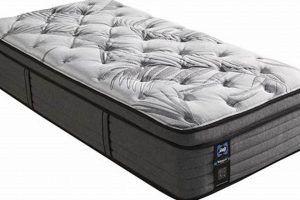The following explores the distinctions between a standard full-size mattress and a full extra-long mattress. The primary difference lies in their dimensions. A standard full mattress typically measures 54 inches wide by 75 inches long, while a full extra-long mattress maintains the 54-inch width but extends to 80 inches in length. As an illustration, an individual requiring additional legroom might find the extended length of a full extra-long mattress more suitable than the standard full size.
The selection of an appropriate mattress size impacts sleep quality and overall comfort. A correctly sized mattress ensures sufficient space for movement and prevents feelings of restriction. Historically, mattress sizes have evolved to accommodate varying body types and sleeping preferences. The emergence of extended-length options caters to the needs of taller individuals who often find standard sizes inadequate. Choosing the right mattress contributes significantly to achieving restful sleep and promoting physical well-being.
Subsequently, this article will delve into a more detailed comparison of these two mattress types, examining their suitability for different individuals, bedroom sizes, and potential applications. Factors such as cost, availability, and related bedding options will also be considered to provide a comprehensive understanding of their respective advantages and disadvantages.
Guidance on Distinguishing Between Mattress Dimensions
The following section provides focused advice regarding the selection of an appropriately sized mattress. Careful consideration of individual needs and spatial limitations is essential for optimal sleep and comfort.
Tip 1: Measure Available Space: Accurately measure the bedroom area to ensure the chosen mattress size fits comfortably, leaving sufficient room for movement and furniture placement. A cramped environment can negatively impact sleep quality.
Tip 2: Assess Sleeper Height: Individuals exceeding six feet in height should strongly consider a full extra-long mattress to prevent discomfort caused by dangling feet or restricted movement during sleep. Insufficient length can disrupt sleep patterns.
Tip 3: Evaluate Sleeping Habits: Active sleepers who frequently change positions may benefit from the additional space afforded by a full extra-long mattress. This can minimize feelings of confinement and enhance sleep quality.
Tip 4: Consider Bedding Availability: Verify the availability of appropriately sized sheets, blankets, and other bedding accessories for the selected mattress size. Non-standard sizes may present challenges in sourcing suitable linens.
Tip 5: Factor in Budget Constraints: Full extra-long mattresses may incur a slightly higher cost compared to standard full-size options. Budgetary considerations should be weighed against the potential benefits of increased size and comfort.
Tip 6: Review Frame Compatibility: Ensure the existing bed frame is compatible with the dimensions of the chosen mattress. An incompatible frame can lead to instability, premature wear, and void warranties.
Tip 7: Prioritize Comfort Preferences: While size is critical, remember to prioritize comfort features like mattress firmness and material. A larger mattress does not guarantee better sleep if the comfort level is unsuitable.
In summation, carefully evaluating individual needs, spatial limitations, and budgetary constraints is paramount when selecting between a full-size and a full extra-long mattress. Prioritizing these factors will contribute to a more informed decision and enhance overall sleep quality.
The subsequent sections will elaborate on specific use cases and provide further comparative analysis to aid in making the most appropriate choice.
1. Dimensions
The physical dimensions of a mattress constitute a primary differentiator between a standard full-size mattress and a full extra-long mattress. Precise measurements dictate suitability for specific individuals, room sizes, and sleeping arrangements. A thorough comprehension of these dimensions is essential when selecting a mattress.
- Standard Full Mattress Dimensions
A standard full-size mattress typically measures 54 inches in width and 75 inches in length. This size is often considered suitable for single adults in smaller bedrooms. As an example, a studio apartment resident may opt for a standard full to maximize floor space while accommodating a single sleeper.
- Full Extra-Long Mattress Dimensions
A full extra-long mattress maintains the 54-inch width of a standard full but extends the length to 80 inches. This extended length caters to taller individuals who require additional legroom during sleep. For instance, a student residing in a dorm room with a full-size bed frame might select a full XL mattress to comfortably accommodate their height.
- Impact on Bedroom Layout
The selected mattress dimensions directly impact bedroom layout and furniture placement. A larger mattress requires more space, potentially limiting available room for other furnishings. Consider, as an example, a compact bedroom where a full XL mattress might dominate the room, reducing space for dressers or nightstands.
- Comparison of Surface Area
Although both mattress types share the same width, the additional length of a full XL mattress provides a larger overall surface area. This increased surface area can enhance comfort for active sleepers who change positions frequently during the night. A restless sleeper, for example, might benefit from the added space of a full XL to minimize feelings of restriction.
In conclusion, the dimensional differences between a standard full and a full extra-long mattress are significant considerations. The appropriate choice depends on individual height, bedroom size, and personal sleeping preferences. These factors collectively contribute to an informed decision that promotes comfort and optimal sleep quality.
2. Space requirements
The spatial demands of a mattress are a critical determinant when choosing between a standard full-size mattress and a full extra-long mattress. Available square footage in the bedroom must accommodate the mattress dimensions while allowing for adequate movement and placement of other furniture. Failure to account for space constraints can lead to an overcrowded and uncomfortable living environment.
- Overall Room Dimensions
The overall size of the bedroom is the most fundamental consideration. A smaller room may be overwhelmed by a full XL mattress, leaving minimal space for walkways or additional furniture. For instance, a bedroom measuring 10 feet by 10 feet may comfortably accommodate a standard full mattress, whereas a full XL could make the room feel cramped and restrict accessibility to closets or windows. This dimension sets the physical boundaries for effective mattress placement.
- Furniture Placement and Clearance
Beyond the mattress itself, one must consider the placement of other essential bedroom furniture, such as nightstands, dressers, and wardrobes. Sufficient clearance around the bed is necessary for ease of movement and accessibility. For example, a full XL mattress may necessitate rearranging or downsizing existing furniture to maintain comfortable walkways and access to drawers or doors. Efficient space planning ensures both functionality and aesthetic appeal.
- Doorway and Stairwell Access
Before acquiring either mattress type, evaluate the ease with which it can be maneuvered through doorways, stairwells, and hallways. A full XL mattress, due to its increased length, may present challenges during delivery or relocation, especially in older homes with narrow passageways. Measure these access points to ensure the chosen mattress can be physically transported into the bedroom without causing damage to the mattress or the property.
- Impact on Perceived Room Size
The size of the mattress visually influences the perceived size of the room. A larger mattress, such as a full XL, can make a smaller room feel even more confined, potentially impacting mood and overall comfort. Conversely, in a larger bedroom, a standard full mattress may appear disproportionately small. Consider the psychological impact of mattress size on the room’s atmosphere when making a selection.
In summary, the “Space Requirements” is an important aspect when selecting a “full xl vs full mattress”, with implications ranging from physical constraints to psychological perceptions of room size. Thoughtful assessment of bedroom dimensions, furniture placement, and accessibility is essential for ensuring a comfortable and functional living space.
3. Sleeper height
The height of the individual intending to use the mattress is a critical factor when differentiating between a standard full-size mattress and a full extra-long (XL) mattress. Inadequate mattress length can lead to discomfort, disrupted sleep patterns, and potential health implications, highlighting the importance of aligning mattress dimensions with the user’s physical stature.
- Optimal Spinal Alignment
Sleeper height directly influences spinal alignment during sleep. If a mattress is too short, the sleeper’s feet may dangle off the edge, causing the spine to be improperly supported. Extended periods of this can contribute to back pain, neck stiffness, and other musculoskeletal issues. A full XL mattress provides additional length, ensuring the entire body is supported, promoting proper spinal alignment, especially for individuals taller than average.
- Pressure Point Relief
Proper weight distribution across the mattress surface is essential for relieving pressure points. When a sleeper’s feet extend beyond the mattress edge, weight distribution becomes uneven, increasing pressure on other areas such as the hips and shoulders. A full XL mattress allows for full body contact with the sleeping surface, distributing weight more evenly and reducing the risk of pressure sores or discomfort in sensitive areas.
- Sleep Quality and Restfulness
Discomfort caused by inadequate mattress length can significantly disrupt sleep quality. Restless tossing and turning, frequent awakenings, and difficulty finding a comfortable position are common consequences. A full XL mattress offers greater freedom of movement and a more relaxed sleeping posture, leading to deeper, more restful sleep cycles. Improved sleep quality translates to enhanced cognitive function, mood regulation, and overall physical health.
- Long-Term Health Considerations
Consistent use of an improperly sized mattress can contribute to chronic health problems over time. Persistent spinal misalignment and pressure point discomfort can exacerbate existing musculoskeletal conditions and increase the risk of developing new ones. Investing in a full XL mattress when appropriate can be viewed as a preventative measure, minimizing the long-term health risks associated with inadequate sleep support.
In summation, “sleeper height” is a crucial variable in the “full xl vs full mattress” decision. Selecting the appropriate mattress length not only optimizes comfort and sleep quality but also contributes to long-term musculoskeletal health and overall well-being. Failure to adequately consider height can lead to discomfort and potential health complications that outweigh any initial cost savings.
4. Bedding costs
The expense associated with bedding represents a notable factor in the comparative analysis of full-size mattresses versus full extra-long (XL) mattresses. Variations in size directly influence the availability and price of sheets, blankets, comforters, and other essential bedding accessories. Consideration of these costs is necessary for a comprehensive budgetary assessment.
- Initial Purchase Price of Bedding Sets
Full XL bedding sets generally command a higher initial purchase price compared to standard full-size sets. This premium reflects the increased material requirements and, potentially, the lower production volume of full XL sizes. For example, a high-thread-count sheet set for a full XL mattress may be 15-25% more expensive than a comparable set for a standard full.
- Availability and Variety
Standard full-size bedding is more widely available across retail outlets and online marketplaces, offering consumers a broader selection of styles, materials, and price points. Full XL bedding, while becoming increasingly accessible, may present fewer options, potentially limiting consumer choice and increasing the likelihood of settling for a less-than-ideal product. This is because standard full sizes have broader demand.
- Specialty and Custom Orders
Individuals seeking unique or highly specialized bedding for a full XL mattress may need to resort to custom orders, which typically incur significantly higher costs than off-the-shelf alternatives. Custom-made sheets, comforters, or mattress protectors can address specific needs or preferences but can easily double or triple the cost compared to standard sizes.
- Long-Term Replacement Costs
Given the potential for increased wear and tear, bedding may require periodic replacement. The higher initial and ongoing costs associated with full XL bedding should be factored into long-term budget projections. A diligent consumer should anticipate that they may replace a full XL sheet set more often due to limited material options and potentially lower durability compared to standard full bedding.
These factors highlight the importance of integrating “bedding costs” into the overall evaluation when choosing between “full xl vs full mattress.” While the mattress itself represents a primary expense, the associated bedding can contribute substantially to the total cost of ownership. A thorough assessment of bedding prices, availability, and replacement needs is crucial for making a financially sound decision.
5. Frame compatibility
The compatibility of a mattress with its corresponding bed frame is paramount for structural integrity, safety, and the longevity of both components. The selection between a full-size mattress and a full extra-long (XL) mattress mandates a thorough assessment of existing or prospective bed frames to ensure proper fit and support.
- Dimensional Mismatch and Support
A significant dimensional discrepancy between a mattress and its frame can compromise support, leading to premature wear of the mattress or potential frame failure. For example, placing a full XL mattress on a frame designed for a standard full will result in unsupported overhang, creating uneven weight distribution and stressing both the mattress and the frame’s structural integrity. Proper frame alignment with mattress dimensions is essential.
- Slat Configuration and Load Distribution
The slat configuration of a bed frame plays a crucial role in distributing weight across the mattress. Inadequate or improperly spaced slats can create localized stress points, leading to mattress sagging or indentations over time. A full XL mattress necessitates a frame with appropriately spaced and robust slats to accommodate its extended length and maintain uniform support. Therefore, evaluating slat design is important.
- Headboard and Footboard Constraints
The presence of a headboard and footboard can impose additional constraints on mattress selection. A frame designed for a standard full mattress may not accommodate the extra length of a full XL mattress, resulting in protrusion beyond the frame’s boundaries. This can pose aesthetic and safety concerns. Assessing headboard and footboard dimensions before choosing a mattress is necessary.
- Warranty Implications
Using an incompatible bed frame can void the warranty of a mattress. Many mattress manufacturers stipulate specific frame requirements, such as proper support and dimensional compatibility, as conditions of their warranty coverage. Utilizing a frame that does not meet these requirements can invalidate the warranty, leaving the consumer responsible for repair or replacement costs in the event of mattress defects. Consulting warranty documentation is critical.
In conclusion, ensuring “frame compatibility” is a non-negotiable aspect of the “full xl vs full mattress” decision. Failure to properly align mattress dimensions with the bed frame can lead to structural issues, voided warranties, and compromised sleep quality. Diligent assessment of frame specifications and mattress requirements is essential for a safe, supportive, and long-lasting sleep solution.
6. Sleeping style
The manner in which an individual sleeps significantly influences the optimal mattress selection. Varied sleeping styles necessitate different levels of support, space, and comfort. The choice between a full-size mattress and a full extra-long (XL) mattress should, therefore, align with these individual preferences to ensure adequate rest and minimize sleep disturbances.
- Active Sleepers and Range of Motion
Individuals who frequently change position during sleepcommonly described as active sleepersrequire a mattress that accommodates a wide range of motion. The additional length of a full XL mattress can provide increased freedom of movement, preventing the sleeper from feeling restricted or falling off the edge. As an example, a sleeper who transitions from a supine to a prone position multiple times throughout the night may benefit from the expanded surface area of a full XL, minimizing sleep disruptions.
- Side Sleepers and Spinal Alignment
Side sleeping is a common position that can either promote or hinder spinal alignment. A mattress of adequate length ensures the sleeper’s entire body, including legs and feet, remains supported, maintaining a neutral spinal position. For taller side sleepers, a full XL mattress is often preferable to prevent dangling feet, which can compromise spinal alignment and lead to discomfort. Proper spinal support is essential for minimizing back and neck pain.
- Back Sleepers and Even Weight Distribution
Back sleepers benefit from a mattress that evenly distributes weight and supports the natural curvature of the spine. While mattress length is less critical for back sleepers than side sleepers, adequate length still ensures that the entire body is supported and not compressed. A full XL mattress can provide a more spacious sleeping surface, allowing for greater arm and leg extension without encroaching upon the edge of the bed. This reduces pressure and promotes circulation.
- Stomach Sleepers and Reduced Restriction
Stomach sleeping is often discouraged due to its potential to strain the neck and back. However, individuals who predominantly sleep on their stomach may appreciate the increased space afforded by a full XL mattress. The extra length can reduce feelings of confinement and allow for a more relaxed sleeping posture. While proper neck and back support should still be prioritized, the added space can enhance overall comfort for stomach sleepers.
Ultimately, aligning sleeping style with mattress dimensions is crucial for optimizing sleep quality and minimizing discomfort. The comparative advantages of a full-size mattress versus a full XL mattress are directly influenced by individual sleeping habits and positional preferences. A careful assessment of these factors is essential for selecting the most appropriate mattress and achieving restful sleep.
7. Longevity
The lifespan of a mattress represents a significant consideration for consumers evaluating a full-size mattress versus a full extra-long (XL) mattress. Durability, construction quality, and usage patterns directly influence the serviceable life of these products, impacting long-term value and cost-effectiveness. Assessing longevity requires examination of material composition, structural design, and expected wear and tear.
- Material Composition and Degradation Rates
The materials used in mattress construction, such as foam, innersprings, and fabric, exhibit varying degradation rates. Higher-quality materials generally demonstrate greater resistance to compression, sagging, and structural failure. A full XL mattress, due to its increased surface area, may be subject to greater stress concentration if constructed with inferior materials, potentially leading to accelerated degradation compared to a standard full-size mattress. For example, a low-density foam core is likely to compress and lose support more quickly than a high-density alternative, particularly under concentrated weight distribution. Therefore, material quality should be viewed as a primary factor for longevity.
- Construction Techniques and Structural Integrity
The methods employed in mattress construction significantly influence its structural integrity and resistance to deformation. Reinforced edges, robust stitching, and durable innerspring systems contribute to enhanced stability and longevity. A full XL mattress, given its extended dimensions, requires meticulous construction to prevent sagging or warping. Improperly secured seams or inadequately supported edges may compromise the mattress’s structural integrity over time, reducing its lifespan. Enhanced construction techniques and robust component integration are crucial for extended durability.
- Weight Distribution and Support Systems
The distribution of weight across the mattress surface, and the efficacy of the support system in accommodating this load, directly impact longevity. A full XL mattress, designed to accommodate taller individuals, must effectively distribute weight to prevent localized compression and sagging. Inadequate support systems, such as weak innersprings or insufficient foam density, can result in uneven weight distribution, leading to premature wear and tear. Optimizing weight distribution through a robust support system is essential for prolonging mattress life. The material used in this area directly impacts how long the mattress will last. The cheaper the materials, the shorter the lifespan.
- Usage Patterns and Maintenance Practices
The manner in which a mattress is used and maintained significantly affects its lifespan. Frequent rotation, proper support from a compatible bed frame, and the use of a mattress protector can extend a mattress’s serviceable life. Neglecting these practices, such as using an unsupported frame or failing to address spills and stains, can accelerate degradation. Full XL mattresses, given their size, may be more challenging to rotate or clean, potentially impacting their longevity if maintenance is not prioritized. Adherence to recommended usage and maintenance protocols is crucial for maximizing the lifespan of any mattress, regardless of size.
Assessing longevity requires a holistic evaluation encompassing material quality, construction techniques, weight distribution, and usage patterns. A durable mattress, whether full-size or full XL, represents a long-term investment in sleep quality and overall well-being. Consumers are advised to prioritize these factors when selecting a mattress, considering that the initial purchase price represents only one component of the total cost of ownership.
Frequently Asked Questions
The following addresses prevalent inquiries and clarifies common misconceptions surrounding mattress dimensions, focusing primarily on distinctions between standard full-size mattresses and full extra-long mattresses. Each question is addressed with a factual and informative approach.
Question 1: Is a full XL mattress simply a longer version of a standard full mattress?
Yes, a full XL mattress maintains the same width (54 inches) as a standard full mattress but extends the length from 75 inches to 80 inches. The primary difference resides in the additional five inches of length.
Question 2: What is the primary advantage of a full XL mattress over a standard full mattress?
The main advantage is increased length, which provides greater comfort and support for taller individuals who may find a standard full mattress too short.
Question 3: Does a full XL mattress require specialized bedding?
Yes, a full XL mattress requires sheets and other bedding specifically designed for its dimensions. Standard full-size bedding will not adequately fit a full XL mattress.
Question 4: Are full XL mattresses more expensive than standard full mattresses?
Generally, full XL mattresses incur a higher cost than standard full mattresses due to the additional materials and potentially lower production volumes. Pricing may vary depending on brand and construction.
Question 5: Can a standard full-size bed frame accommodate a full XL mattress?
No, a standard full-size bed frame is not designed to properly support a full XL mattress. A frame specifically designed for full XL dimensions is required to ensure adequate support and prevent damage to the mattress.
Question 6: Is a full XL mattress suitable for couples?
While a full XL mattress offers more length, its width (54 inches) may be insufficient for couples seeking ample personal space. A larger mattress size, such as a queen or king, is generally recommended for couples.
Accurate information is essential for informed decision-making. Understanding the dimensional differences, associated costs, and compatibility requirements allows consumers to select the mattress best suited to their individual needs and preferences.
The ensuing section transitions to a comparative analysis of specific use cases, further elucidating the suitability of each mattress type for various scenarios.
Full XL vs Full Mattress
This exploration of “full xl vs full mattress” has illuminated critical distinctions that directly influence sleep quality, comfort, and long-term cost. Dimensional variance, spatial demands, sleeper height considerations, bedding expenditures, frame compatibility imperatives, sleeping style accommodations, and longevity factors all contribute to a nuanced understanding. Careful consideration of these elements is paramount for informed mattress selection.
Ultimately, the choice between a full XL and a standard full mattress transcends mere preference; it necessitates a thorough assessment of individual requirements and practical limitations. Understanding these factors will lead to a more informed decision to promote restful sleep and maintain long-term value.


![Best Twin XL Pillow Top Mattress [2024 Guide] Organic & Natural Mattress Buyer’s Guide: Non-Toxic Sleep Solutions Best Twin XL Pillow Top Mattress [2024 Guide] | Organic & Natural Mattress Buyer’s Guide: Non-Toxic Sleep Solutions](https://mattressworldpa.com/wp-content/uploads/2025/07/th-873-300x200.jpg)




